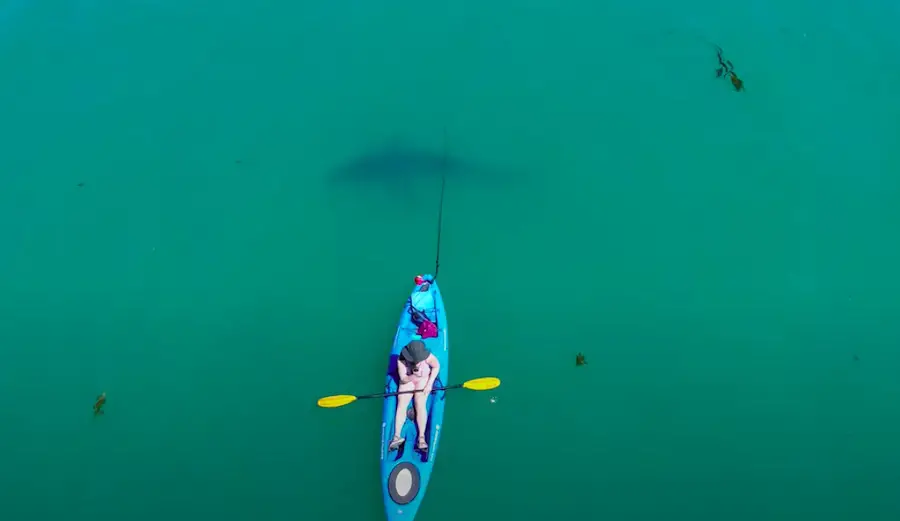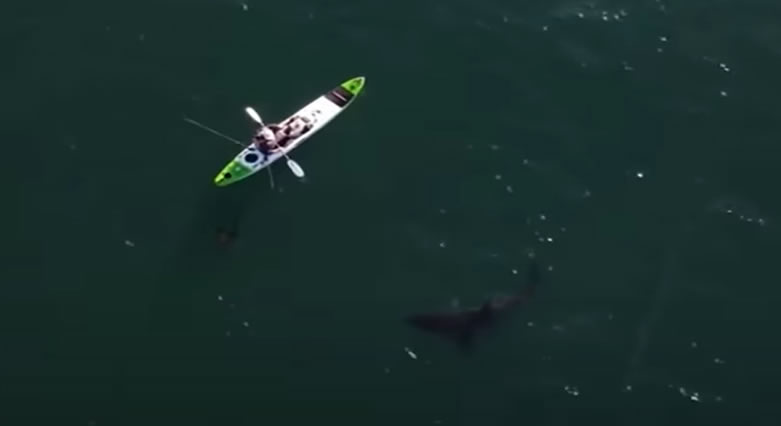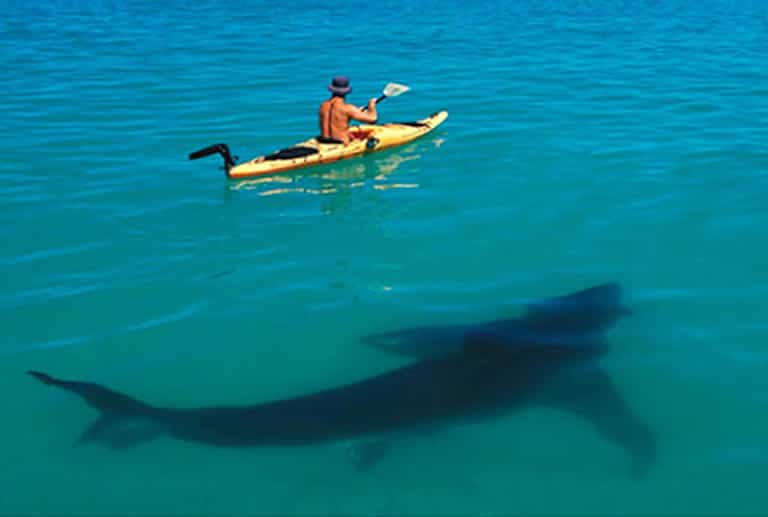Although there is information available to kayakers to help them protect themselves against shark attacks there is scant information on if sharks attack kayaks and the potential causes of them.
Contents
Do sharks attack kayaks?
Although they much rarer occurrences than people think, sharks do attack kayaks because they sometimes mistake the boat for prey.
There are an average of 80 unprovoked shark attacks yearly with very little being directed towards kayaks.
For example, in 2017 there were 155 shark attacks worldwide – 30 of which were provoked.

From the 88 unprovoked shark attacks only 18 were on boats.
These boats were a wide range of vessels and not just kayaks.
So, you can see that shark attacks on kayaks are extremely rare.
When sharks attack they are not trying to dislodge the kayaker in order to eat him/her they are actually investigating the boat to see if it is something they can eat.
A shark encounter will start with the shark bumping the boat to investigate if it is potential prey though it may also take a bite out of the boat to try to determine if it is something worth eating.
In most cases when a shark fully attacks a kayak it has mistaken it for a seal or sea lion.
Shark attack or shark encounter – why “shark encounter” is a much more accurate term
Although shark attacks on kayaks do occur they are very rare.
Because a full blown attack rarely happens when a kayaker comes into contact with a shark it is much more accurate to refer to these incidents as shark encounters.
In most cases when a shark approaches a kayak it is actually only investigating rather than attacking.
As a predator a shark will always be on the look out for easy prey. As they attack from deep in the water they usually attack their prey from beneath.
A kayak from underneath can look like potential prey to a shark.
In fact, to a shark the underbelly of a kayak can look like a seal or a sea lion.
But, rather than attack outright a shark will usually investigate the potential prey first.
This is what happens when a shark bumps a kayak or boat.
A shark is an exceptionally good hunter. It so effective at what it does that it has remained largely unchanged since prehistoric times.
No evolution was needed because this beast of the water is already a perfect hunter and you cannot improve on perfection.
Most marine biologists agree that if a shark was determined to capsize a kayaker there is very little the kayaker could do about it!
With such few fatalities occurring from shark attacks we can see that encounters with these water-based hunters are very likely to be attacks.
More likely they are investigations by the shark only.
A shark, when it first approaches a kayak, is investigating rather than attacking.
The shark wants to find out of it has discovered something worth eating before it expends energy attacking it.
Although the video below is titled Hammerhead Shark Attacks Kayak Fishing it is a perfect example of a shark encounter rather than a shark attack.
The shark is investigating the kayak to see if it is prey and, due to the correct actions taken by the paddler, eventually withdraws allowing the kayaker to paddle to shore and safety.
Hammerhead kayak encounter (video)
The truth about shark attacks on kayaks & other boats
Shark attacks are rare. They are rare for any type of boat but much rarer for kayaks than most others.
In fact in 2019 there were only 64 confirmed unprovoked shark attacks worldwide with only 2 fatalities.
There were 5 fatalities in all but it is unsure if the other 3 were from provoked attacks, where the humans initiated the contact with the sharks.
Unfortunately, the modem perception of shark attacks comes from movies like Jaws that sensationalize this type of event and use a large dose of poetic license to tell their stories.
Most shark attacks are better described as shark encounters because the shark does not actually attack the kayaker and no injuries are sustained.
But, of course there are real shark attacks that do happen and kayakers should never take a blasé attitude around these elite predators.
Sharks are extremely dangerous and if you fall out of your boat into the water you run the risk of the shark taking a bite out of you.
Even if you are lucky and the shark realizes you are not prey it could leave you missing a limb. So you should take precautions.
Why real shark attacks sometimes happen & how to easily avoid them
When a shark truly attacks a kayak and fatalities occur it is because the shark has mistaken the kayak, and the humans onboard, as prey.
A shark’s natural diet is marine life, and not just any marine life, but saltwater marine life.

For example, Great White Sharks will eat fish when they are young and have even been known to eat other sharks.
As they gain in size they prefer sea lions and seals as they are bigger.
Human flesh and blood to a shark is far from a tasty dish.
They much prefer the taste of meat from saltwater marine life than meat from land based animals, including humans.
From 300 species of shark only 10 types are known to have ever attacked human beings and when they do attack it is because they have confused the human with their preferred prey.
When a shark attacks a kayak it is most likely confusing the boat with a seal or sea lion.
How to protect yourself against a shark attack while on a kayak
Remember that shark attacks are rare. Try not to let the fear of sharks stop you from kayaking in the ocean.
Our guide to kayaking in the ocean shows you just how many wonderful adventures you can have in the sea.
But do take precautions.
In order to stay safe and protect yourself against shark encounters do the following:
- If any blood is in the water avoid it.
- Stay away from slicks from fishing boats.
- If there are cloudy river mouths they are best avoided.
- Be wary of suspect waters, especially at dusk and dawn which are prime shark hunting times.
- If you don’t want a shark to mistake you for his next meal, stay far away from large groups of fish, sea lions and seals.
- When you see a shark do not panic. If you frantically try to paddle to safety you will only succeed in making yourself look like an injured seal and this will simply attract the attention of the shark.
- If a shark starts to approach your kayak, or gets aggressive and bumps it, give it a hard tap on the snout with your paddle until it gives you enough room to paddle to safety.
- Always carry some type of emergency alert item with you such as a whistle, or better still a flare, so you can alert others of your plight if things get too dangerous. See our essential kayaking items list.
A final note: Do sharks attack kayaks – rarely, but you should still take precautions
Hopefully the information in this article has given you all the information you need regarding shark attacks on kayaks.
Hopefully it has also put your mind to rest that the potential dangers of kayaking in the ocean don’t include shark attacks.
So let’s summarize the information in this article.
Shark attacks on kayaks are rare. Fatalities from shark attacks are even rarer.
Shark attacks have gone done across the world in recent years.
Most shark attacks on kayaks are not really attacks at all and should be considered more as encounters.
This does not mean they are not dangerous and you should always take precautions when kayaking in ocean waters especially those that are known to have sharks.
Always carry some type of emergency beacon so you can alert others if you get into some serious trouble.
This can be as simple as carrying a whistle or flare.
If you are worried about other dangers associated with kayaking read this article.

